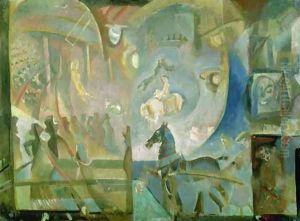Georgij Bogdanovic Jakulov Paintings
Georgij Bogdanovic Jakulov, born in 1884 in the Russian Empire, was an artist whose work spanned the realms of painting, graphic design, and stage design, reflecting the tumultuous changes of the early 20th century. Jakulov's early life was marked by an exposure to the rich cultural and artistic heritage of Russia, which would deeply influence his later work. He studied at the Moscow School of Painting, Sculpture and Architecture, where he was exposed to a variety of artistic movements and theories, from traditional Russian iconography to the burgeoning styles of European modernism.
Jakulov's artistic career was notably diverse; he did not confine himself to a single medium or style. Early in his career, he was deeply influenced by Symbolism and Art Nouveau, integrating complex, ornamental designs with mystical and often melancholic themes. As the political and social landscape of Russia began to shift dramatically with the onset of the Russian Revolution and subsequent civil war, Jakulov's work also underwent significant transformation. He became involved with the avant-garde circles, experimenting with Abstract art and Constructivism, reflecting the revolutionary spirit of the times.
Throughout the 1920s and 1930s, Jakulov's work increasingly dealt with themes of industrialization and modernity, often incorporating geometric shapes and vibrant colors that celebrated the new Soviet ethos. However, despite his alignment with avant-garde movements, Jakulov remained deeply connected to the cultural and historical motifs of his homeland, weaving traditional Russian elements into his modernist compositions.
Jakulov's contributions to the world of art were not limited to canvas and paper. He was also a renowned stage designer, creating innovative and expressive sets and costumes for the theater, which further exemplified his versatility and creative vision. His stage designs were celebrated for their ability to merge the visual and dramatic arts, creating immersive and dynamic environments that enhanced the theatrical experience.
Despite his achievements, the increasing restrictions on artistic expression in the Soviet Union during the 1930s and 1940s affected Jakulov's career. The rise of Socialist Realism as the state-mandated style led to a decline in the appreciation and freedom for avant-garde artists like Jakulov. Nevertheless, he continued to work, adapting his style while maintaining his unique artistic voice until his death in 1953. Today, Georgij Bogdanovic Jakulov is remembered as a pioneering figure in Russian art, whose diverse body of work reflects the complex interplay of tradition and modernity, individual expression, and collective identity.
